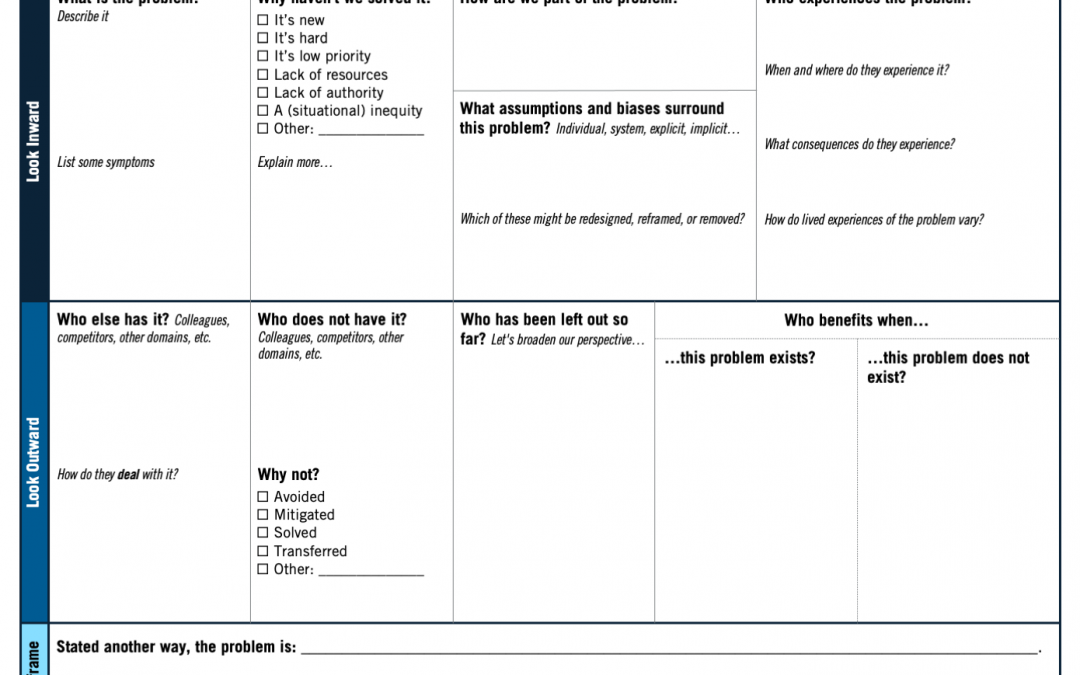Learn more about the equity-driven updates to one of our most popular ITK tools.
– – –
As part of Team Toolkit’s collaboration with the MITRE Social Justice Platform, we embarked on taking a fresh look at our ITK tools with an equity lens.
Equity-driven design thinking encourages us to create not just inclusive and diverse solutions, but to create equitable solutions. Equitable solutions are available to all (e.g., equal access), and they also help equalize who benefits from the solution (e.g., many groups benefit, not just one). Equity-driven design thinking helps ensure we design at the margins, for those who have the greatest need, who are traditionally left out of the design process. When we design at the margins, we design for everyone.
One way we can do this is by considering who has been traditionally “left out” and to design solutions that level the playing field. In addition, equity-driven design thinking encourages us, as the designers, to take a critical look at our own assumptions and biases that we inherently bring to the table and implicitly embed as part of the final solution.
First up was one of our most popular tools: Problem Framing canvas.
Visually, you’ll notice that we’ve partitioned the Problem Framing canvas into three areas: Look Inward, Look Outward, and Reframe.
Look Inward speaks directly to the additional step, Notice, in equity-driven design thinking. In this section, participants are guided to look not only at the problem they are facing, but also how they themselves might be part of the problem. We’ve added questions to encourage groups to explicitly discuss assumptions and biases, and as part of the Reflect step in equity-driven design thinking, participants are asked to imagine which of these assumptions may be designed, reframed, or removed.
New questions have also been added to dig deeper into who experiences the problem. We ask participants to consider the lived experiences and consequences that users who have this problem face, which may otherwise have been overlooked. We also added equity-related factors for why this problem hasn’t been solved, such as lack of authority or a situational inequity.
Look outward also speaks directly to the Notice step in equity-driven design thinking. In this section, we encourage participants to broaden their thinking to find more insights and inspiration by learning from others who may or may not have this problem.
We’ve added questions to encourage participants to consider who has been left out, as well as to examine who benefits when the problem does or does not exist. We’ve also added an equity-related factor for why others don’t have this problem, which is that it’s been transferred.
Reframe culminates the Reflect step in equity-driven design thinking by asking participants to synthesize their insights and discussions into a succinct problem statement. We’ve streamlined the suggested “How Might We” statement to help groups create more powerful, action-oriented statements.
Lastly, we’ve introduced new “Question Bank” and “Facilitation Tips” sections in the Instructions to further assist problem framing discussions. These additional questions can provide more richness to the discussion, as well as deeper inquiry into the problem.
One final important point – Although we’ve updated the Problem Framing canvas with an equity-driven lens, this tool can be used to guide discussions on ALL problems, not just equity-related problems. By embedding this equity-driven lens into the questions and the tool itself, this naturally leads to discussions that will help create more equitable solutions since they bring equity to the forefront, rather than relying on a participant to bring them up.
We hope you find the updated Problem Framing canvas useful, and let us know what you think in the comments below!

